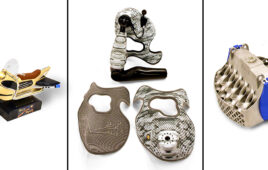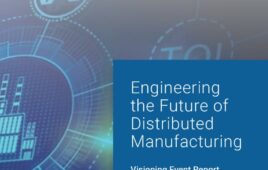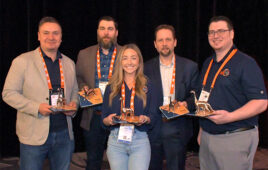
Running TwinCAT 3 software, the Beckhoff CP6706 Panel PC with 7-in. touchscreen serves as the durable all-in-one controller and HMI for PostProcess machines, enabling easy access to the proprietary Automat3D software and HMI.
Edited by Mike Santora
3D printing, also known as additive manufacturing, could become one of the greatest advances in manufacturing. A nearly infinite number of shapes can be created using 3D printing with all types of materials including plastics, metals, and even food. The process creates shapes that would otherwise be problematic, if not impossible, to make without extensive multi-axis machining or highly specialized tools.
Almost all manufacturers in the Fortune 100 and 500 are using 3D printing to prototype parts. This trend of direct digital production has taken off to meet the needs for both low- and high-volume manufacturing applications.
However, the 3D printing process is not without its challenges. Building complex geometries with a 3D printer with overhangs or other asymmetrical contours requires the use of support materials. These supports ensure that a work piece does not collapse during printing. But the support materials must be removed afterward, which creates inefficiencies.
In addition, 3D printed parts often require finishing processes to achieve the desired look and feel of a completed part while meeting tolerances for size, texture and precision.

A selection of EtherCAT I/O
terminals from Beckhoff assures fast, streamlined communication and directly integrates safety equipment via the TwinSAFE I/O (yellow terminals).
Historically, highly skilled artisans performed post-building processes by hand, a labor-intensive process that slowed production. PostProcess Technologies, a company specializing in additive manufacturing post-production machines, had an idea – automate the finishing process.
PostProcess founder and current President and CTO Daniel J. Hutchinson, building on his extensive software background, created the Agitation Algorithm (AGA). This software, along with a series of patent-pending machines, leverages the chemistry of detergents and abrasive media to dramatically increase throughput during post-processing of 3D parts.
These patent-pending machines required key components. PostProcess turned to Beckhoff Automation for help with the company’s newest machine, the Hybrid DECI Duo. This multi-function, space-saving machine removes support material and improves the surface finish.
The DECI Duo uses a combination of optimized energy from chemistry, guided by the AGAs to remove support material and provide the desired surface finish while preserving fine-detail part geometries. It handles advanced thermoplastics, light-cured resins, and metals.
The proprietary Automat3D software powered by the Agitation Algorithms allows different agitation levels for a variety of geometries, enabling customers to mix geometries into batches to save time and operate more efficiently.

Motion control for the DECI Duo is accomplished via TwinCAT 3 NC/PTP and AX5103 compact servo drives.
In addition, the process is precise. “Damage to parts while being finished is simply not an option,” said Michael Frauens, principal process development engineer. “Often, these parts cost tens of thousands of dollars and may have taken weeks or months to design and build. The Automat3D software accurately inspects and interprets each part – regardless of geometry. In this way, we can provide reliable support removal and dependable surface finishing, producing ‘customer-ready’ parts, every time.”
As the PostProcess team began research for the technologies, they knew they needed proven, robust automation components. They determined that a full-featured PC-based control system from Beckhoff offered the best combination of price and performance for their needs. “We felt a PC-based control system would add an ideal level of familiarity for our customers,” said Hutchinson. “Since most of the 3D printers are not PLC driven, but rather PC driven, a familiar platform goes a long way to shorten the learning curve.”
The Beckhoff CP6706 Panel PC has a 7-in. touchscreen and multi-core Intel Atom processor (4 Core) and serves as the all-in-one control and HMI device for the DECI Duo system. The control can communicate between separate devices, external sources and applications. It uses the Windows 10 IoT operating system (OS).
TwinCAT 3 software from Beckhoff serves as the back-end for the DECI Duo system, providing real-time automation of the part post-processing operations. PostProcess implements several TwinCAT 3 runtimes on the controls, including the TwinCAT PLC and 10 axis NC/PTP options. “TwinCAT 3, and in particular its integration with Visual Studio, is huge for us. We use Visual Studio Team Services for our configuration management, so the availability of industry-wide standards is beneficial. The ability to test the software on a virtual machine helped reduce our integration time,” said Dan Wascak, controls development engineer. The PostProcess team has also standardized on a motion system from Beckhoff, a selection of AM8000 series servomotors with One Cable Technology (OCT), and several AX5103 EtherCAT servo drives.

The internal rotary table leverages several Beckhoff servomotors with One Cable Technology (OCT), including the AM8543 shown here.
EtherCAT communication helps speed implementation of the motion system, and provides a complete system bus in the Hybrid DECI Duo. EL series EtherCAT I/O terminals, also from Beckhoff, are installed across all PostProcess production lines. PostProcess has also integrated safety technology using TwinSAFE I/O technology in the EtherCAT system. Special safety equipment such as e-stops and guard doors are connected through TwinSAFE I/O terminals.
With the Beckhoff system, the PostProcess team noted their development time was cut in half. “Much of this is due to the flexibility of TwinCAT 3 software and the ability to reuse function blocks and other code on subsequent machines,” said Marc Farfaglia, engineering manager. “The PC-based system lets us easily transfer code and run machines in a minimal amount of time.” As the 3D printing and additive manufacturing market continues to evolve at a rapid clip, it is this level of flexibility that will help OEMs like PostProcess shape the future of the industry.
PostProcess
www.postprocess.com
Beckhoff Automation
www.beckhoffautomation.com
Filed Under: 3D printing • additive • stereolithography, Make Parts Fast




